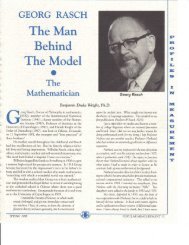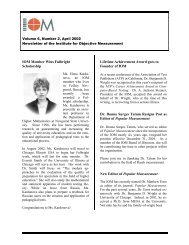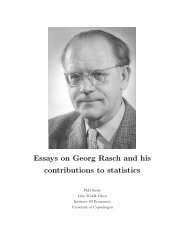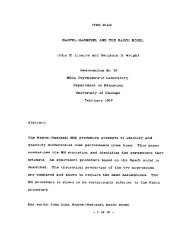Memo # 1964-2 PDF - Verio
Memo # 1964-2 PDF - Verio
Memo # 1964-2 PDF - Verio
Create successful ePaper yourself
Turn your PDF publications into a flip-book with our unique Google optimized e-Paper software.
'e 2) In e.g. psychophysical threshold experiments a subject<br />
is usually exposed to the same stimulus a large number of times.<br />
On the assumption that the repetitions do not affect the judgements<br />
of the subject this procedure gives the opportunity of<br />
estimating each X i separately and hence studying directly how<br />
the situational parameter varies with subject and with strength<br />
of stimulus. And then we may or may not find the multiplicative<br />
rule laid down in 2).<br />
For the intelligence tests we shall deal with experience has<br />
shown that on one repetition the results are usually somewhat<br />
improved. A large number of repetitions have not been tried,<br />
mainly because the questions are such that it seems almost certain<br />
that several of them will easily be recognized after a certain<br />
number of repetitions. Therefore the possibilities for a direct<br />
approach would seem remote.<br />
To compensate we take recourse to an assumption that at any rate<br />
seems rather bold, possibly even artificial, namely that X. )di<br />
can be factorized into a subject parameter and an item parameter.<br />
However, combined with the two other assumptions it produces a<br />
model that turns out to have rather remarkable properties, some<br />
of which even lead to a very careful. examination of how well the<br />
model represents the data (cf. section 6).<br />
Provided the two kinds of parameters can be operationally defined<br />
they also have a clear meaning, to be derived from the probabilities<br />
obtained by inserting (3.2) into (3.1):<br />
(3.3)<br />
1<br />
Of'11)<br />
1-Cr: E 7 1 ' 7— ) 1+F E<br />
'D i<br />
In fact, if the same person is given items with f i t s approaching 0<br />
then his probability of giving a correct answer approaches 0 while<br />
his probability of giving an incorrect answer tends to unity.And<br />
that is true for every person - provided the model holds. Similarly,<br />
when E i gets large the probability of + tends to 1 and the<br />
other one to O. Thus with increasing e i the items become easier,<br />
so colloquially we may call E d_ "the degree of easiness" - and its<br />
reciprocal , S i =1/c t "the degree of difficulty" - of item i.<br />
On the other hand, giving the same item to persons with F. 0 's<br />
approaching 0 we get probabilities of correct answers tending to<br />
0 and if &i) increases indefinitely the probability tends to 1.<br />
And this holds for every item. Thus we may colloquially mern Lon<br />
& I) as "the ability of subject)) " - with respect to the kind. pf<br />
items in question.<br />
In the definition of F, D and E i<br />
there is an inherent indeterminacy.<br />
In fact, if y , 1)= n and E i , i = 1,...,k is a set of<br />
solutions to the equations<br />
(3.4)<br />
E =<br />
1.)<br />
. k<br />
)..)1









